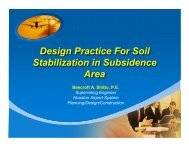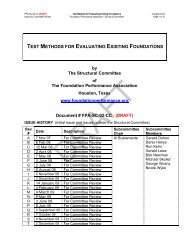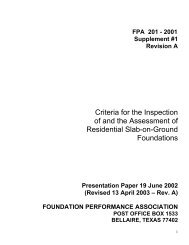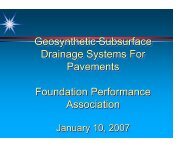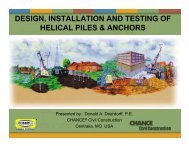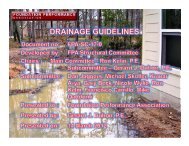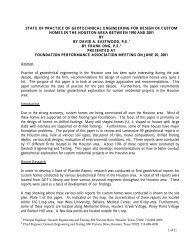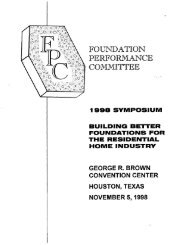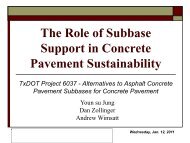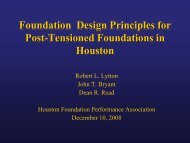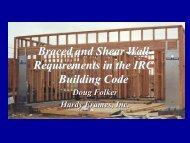Soil-Structure Interaction Seminar - Foundation Performance ...
Soil-Structure Interaction Seminar - Foundation Performance ...
Soil-Structure Interaction Seminar - Foundation Performance ...
You also want an ePaper? Increase the reach of your titles
YUMPU automatically turns print PDFs into web optimized ePapers that Google loves.
J<br />
CASE NO. 10 - THE USE OF SPREAD FOOTINGS<br />
During a recent meeting of the <strong>Soil</strong>s-<strong>Structure</strong> <strong>Interaction</strong> Subcommittee, there was a<br />
discussion on the use of spread footings. I promised to provide information on<br />
buildings I had inspected with such foundation types. So, here they are.<br />
The first example is a very large home located in the Farnham Parle subdivision,<br />
where home dollar costs can be on the order of seven digits. The relative heights<br />
we measured on the interior floors of this building are shown in Figure 12. It is<br />
very obvious that the floors are very flat. In addition, there was no visible<br />
eviaence of foundation shifting. The building plans showed the foundation to be a<br />
reinforced concrete, grade beam stiffened slab type supported on spread footings.<br />
The soils are lenown to be of a loam consistency on the surface with strong clays<br />
from 6 inches to a depth of 6 feet below the surface (3).<br />
The second example ;sa residential building located in the River Dales Subdivision<br />
of Houston, Texas. The soil type and the foundation design, at least according to<br />
the drawings, was similar to that described in the first example; except, this<br />
structure was over 50 years old. Further, it had not been occupied for at least 2<br />
years and, although it was in a general run-down condition, there were no cracles in<br />
the bricle, no cracles in sheetrocle, and all of the doors fit well in their frames,<br />
despite the fact that no one had watered the ground next to the slab nor had pruned<br />
the trees. The floor height measurements, contained in Figure 13, show the floors<br />
to be comparatively flat.<br />
Certainly, this can not be considered to be a significant statistical sample; but,<br />
it does serve to demonstrate that there is perhaps a place for this type of foundation<br />
design.<br />
CASE 11 - SLOPE VERSUS FAILURE<br />
A concern was recently made that perhaps too much emphasis was being placed in the<br />
use of water level measurements in determining the need for repair. Since I can<br />
only deny this allegation as it might apply to our firm, I wish to cite the two<br />
following examples.<br />
The first example is displayed in Figure 14. This is a one story building that has<br />
a comparatively high degree of slope on the interior. The building is located in<br />
West Houston on a soil that is shown to be relatively non-expansive. Our clients had<br />
executed an Earnest Money Contract on the property and our inspection was in<br />
conjunction with the sale. Despite this slope, there was no foundation-induced<br />
damage on the interior or exterior of the building. Counters, frames, and sills<br />
were level. In fact, the kitchen counter was measured to be over one inch higher<br />
off of the floor at one end than at the other. Obviously, the counter was installed<br />
over a sloping floor. We understand that our clients did purchase the property.<br />
The second example is just the opposite. From Figure 15, it can be seen that the<br />
floors are comparatively level. Yet, there was a comparatively severe amount of<br />
damage to the front of the building. The damage seemed to indicate that the front<br />
showed the soils to be expansive. The movement apparently occurred when gutters were<br />
added. The sequence of events that caused the damage must be speculated. Certainly,<br />
corner had settled but the measurements indicated that it had not. <strong>Soil</strong>s testing<br />
-6-



